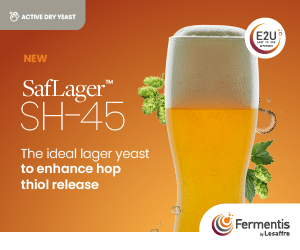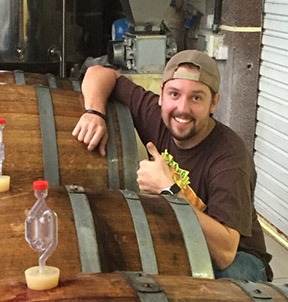Yeast Selection: Tips From the Pros
Yeast is the most critical ingredient to determine the outcome of your beer. With such a wide variety available, choosing the right strain for each batch cannot be overlooked.
Kevin Lane is the Technical Sales Support Manager of the Americas for Fermentis.

The primary characteristics for strain selection should revolve around the beer the brewer is looking to produce. If the brewer is looking for a specific flavor profile (more esters, less esters, phenolic character, neutral, etc.) they should select a yeast based on the manufacturer’s information about the flavor profile. Additionally, the attenuation range should be considered for the specific profile of the beer. If the brewer is looking to produce a high-alcohol beer they need a strain that is capable of high-gravity fermentation. Lastly, the brewer should consider whether they can keep the temperature in the range best suited for each yeast. Yeast suppliers do their best to communicate these parameters through their websites and publications.
Brewers should also consider the yeast’s interaction with raw materials. Fermentis has performed applied research studies on how strains interact with raw materials. So far we have communicated primarily on yeast’s interaction with hops. The strains SafAle S-04, SafAle K-97, and SafAle S-33 have shown strong, complementary interactions with American hops, primarily varieties rich in thiols and their bound precursors, but also with terpenic hop varieties; either bio-converting those precursors and liberating aromatic thiols and to some extent terpenes; and/or producing flavors; thus enhancing the typical hop flavors and fruity character produced by those hops, especially in styles like New England IPA.
Homebrewing isn’t limited to what is “normal” in terms of strain selection and offers a chance to play with uncommon strains (or multiple strains) for specific styles. For example, I enjoy trying multiple strains in a split batch, where everything is the same except for the yeast strain and maybe the fermentation temperatures to adjust to each specific strain. This would be the scientific method to really see the impact of the yeast and allowing the brewer to make an educated decision on which strain is better. Remember to adjust the pitch rate for whatever volume you are fermenting to make sure the profile is repeatable in a “normal” sized batch.
I wouldn’t say there are common “mistakes” made by those new to brewing when it comes to yeast selection, but rather that the brewer is selecting a strain that they aren’t familiar with and get unexpected results. For example, if a brewer selects a POF+ (phenolic off-flavor positive) strain, without knowing that it has the capability to produce phenols. It is not difficult to understand how this can happen, if the brewer is focused on producing a beer with high isoamyl acetate or other esters. Additionally, we have found that phenolics interfere with the perception of hops in hoppy beers, which can come as a surprise to brewers making IPAs and trialing a wide range of yeast strains. In this case, the beers made with POF+ yeast strains may look good on paper, but then once tasted will not have the same flavor perception or expression of hoppy character due to the interference of the phenolic compounds. In order to have the same “hop character” the brewer would have to increase the hop dosing in the POF+ yeast strain beer.
Understand that the information produced by suppliers are in controlled, standardized experiments and can differ when the yeast is introduced into a different wort or media. This is especially true for attenuation and flavor profile, as there are a number of adjuncts (sugars, juices, alternative grains, honey, etc.) that will impact the fermentability of the wort and also introduce precursors for flavor compounds.
Fausto Yu-Shan Technical Product Support Man at Wyeast Laboratories Inc.

The primary characteristic of a yeast strain should be if it is appropriate to the beer style that it is intended to brew. After knowing the planned beer style, there are many other considerations when selecting a yeast strain, which can be separated into fermentation characteristics and economic criteria.
For fermentation characteristics:
Alcohol Tolerance: Important to know it when brewing high-gravity beers and as a general rule.
Temperature Range: Depending on the brewing equipment setup available, the homebrewer can plan which yeast strains will perform at their best for his or her brewing conditions.
Attenuation: Will indicate the amount of sugar the yeast can consume to produce alcohol, which can be controlled by the ingredients in the recipe or mashing temperatures.
Flocculation: Will influence if the beer needs filtration, or depending on the beer style, if it needs to be cloudy. Likewise, it also helps in the effortless way to harvest the yeast for subsequent batches.
Flavors and Aromas: Some yeast strains will enrich the flavor or aroma, such as wheat yeast strains enhancing the banana aroma.
Vitality: As any living organism, the more active and stronger cells are selected, which in brewing will influence the fermentation performance and therefore beer production.
Viability: Knowing the quantity of living cells will indicate the capacity to adapt to an environment, as well as how the percentage of living yeast cells will impact the fermentation process.
Even on a small scale, the economic criteria such as price, availability, versatility, and yeast supplier are important to consider.
For the beginning homebrewer we recommend starting with a versatile yeast strain, such as Wyeasat 1056 American Ale because it can ferment at a higher temperature range, so in case of a mistake it can still be resolved. One of the biggest mistakes I see among homebrewers is having high expectations when they start the hobby trying to brew Belgian or more complicated beer styles and after several discouraging results the enthusiasm fades away. Once the homebrewers become experienced, they can move on to the Belgian or lager beers to gain experience with the yeast strains and experiment to know how far they can manage them. After that, feel free to move on to Bretts and lactic acid bacterias to create the most appetizing flavors and aromas you can imagine.







